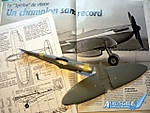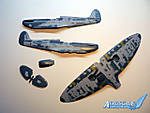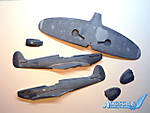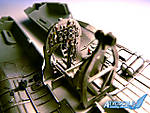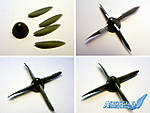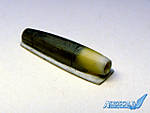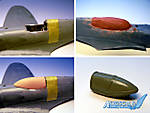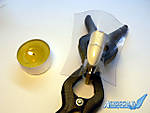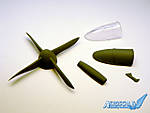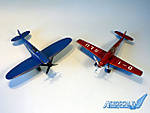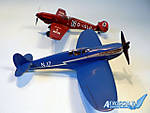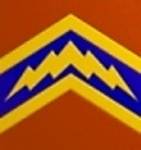1⁄35Speed Spitfire
13
Comments

History
When the prototype of the spitfire first flew in 1936, the British press saw in it the "fastest fighter in the world". The fastest fighter, maybe, but not the fastest aircraft because, at the same moment, the Macchi-Castoldi MC 72 was the world top speed record holder with a mark of 709 km/h (440,7 mph). Despite the fact that the record was well above the potential of Sir Reginald Mitchell's plane, both the British Air Ministry and Supermarine decided to push the new Spitfire design to it's limits by modifying the 48th airframe (serial K9834) to become the type 323 or, more familiarly, the "Speed Spitfire". The challenge was not to beat the Macchi-Castoldi (which was a seaplane), but the Hughes H-1 which was the fastest land-plane aircraft with a a top-speed of 566 km/h (352 mph). This record was at that time within the potential of the British prototype.In summer 1937, the Rolls-Royce engineers began to work on a new "Merlin II" powerplant which was able to produce 1536 hp. This was almost one third more than the initial engine. The K9834 airframe was fitted with this new motor but this was not the only modification. The military equipment was deleted, the numerous access panels were removed and the surface of the plane was smoothed with the use of flush rivets. To reduce drag, the wing tips were rounded and the total wingspan was reduced to 10,26 m. A new high pitch four blade wooden propeller was designed with a smaller diameter to reduce the circumferential speed and eliminate the supersonic flow around the blades. The windshield and the canopy were streamlined and finally, the tailwheel was replaced by a fixed tail skid. The modified plane weighed 2470 kg, 135 kg more than the standard version!
In November 1937, Rolls Royce hoped to obtain 1995 hp out of the special version of the Merlin, which would have been enough power for the Speed Spitfire to reach 603 km/h (375 mph) at low altitude. But at the same time, the Messerschmitt Bf 109 V13 was already able to fly 608 km/h (378 mph)! From now on, the type 323 had to reach 616 km/h (383 mph), 1% more than the german plane, for the record to be approved. With further modifications and even more power (2122 hp) the engineers still hoped they could break the record. The first flight of the Speed Spitfire took place in November 11th with Mutt Summers as test pilot. After that, all the panel lines of the aircraft were filled (except around the engine), the surface was painted in Royal Blue and Silver color and finally everything was polished.
In February 1939, Harry "Bruin" Purvis managed to reach 656 km/h (407 mph) with the Speed Spitfire at the altitude of 990 m. At ground level the speed would have been slower, but still enough to beat the Germans. However, the British knew that Heinkel was about to enter the competition so it was imperative to gain a few km/h (mph) more. It was decided to delete the big radiator under the right wing to improve aerodynamics. With this modification, a top speed of 684 km/h (425 mp/h) at low level was anticipated. To replace the external radiator, a new internal cooling system was designed which allowed the plane to fly the few minutes necessary to break the record. Work on the new cooling system only began when suddenly any effort was made useless: the Heinkel He 100 set the absolute World Speed Record to 753 km/h (468 mph) and less than a month after, the Messerschmitt 209 flew even faster! So fast that the record of 755 km/h (469 mph) was only broken on August 16, 1969 by a highly modified 3100 hp F8F-2 Bearcat, at an average speed of 483.041 mph!
Of course this meant the end of the Speed Spitfire project. The plane was crated and later used as a static demonstration plane for the "Salon aéronautique" of Bruxelles in summer 1939. This could have been the end of the Speed Spitfire but in 1940, the RAF desperately needed combat planes. The type 323 was summarily reequiped and fitted with a Merlin XII engine and a three blade propeller with variable pitch. However, the modifications didn't allowed any armament to be fitted inside the wings and the fuel capacity was also much lower than on a standard Spitfire. The only squadron that could have made good use of this hybrid plane was the Photographic Reconnaissance Unit (PRU) based at Heston. The Speed Spitfire, with it's smooth finish, still was one of the fastest aircraft in the world and Wing Commander Geoffrey Tuttle expected to be able to safely fly reconnaissance missions over France with it. Alas, he soon realized that he would have ran out of fuel 35 km before reaching the British coast on it's return flight!
The Speed Spitfire finished it's career as a liaison aircraft and became the personnal plane of the Commander of the 106 Photo Reconnaissance Wing, Air Commodore John Boothmann. Some said he flew over Normandy on June 6th 1944 to shoot pictures of the D-Day beaches, but this could well be a legend. Finally, K9834, the 48th Spitfire ever made, was scrapped in June 1946... without to have beaten only one record.
Building the kit
To build a Speed Spitfire model, I first needed a "donor" kit. Tamiya's Mk. I kit (ref. 61032) was an obvious choice since the kit is excellent and easy to build. First I filled almost all the panel lines with putty, except for those around the engine which were visible on the real plane (the engine had to remain accessible for servicing). The underwing radiator was also eliminated and the surface could then be sanded smooth.The cockpit was built as per instructions, but without the military equipment in it (gunsight, radio, gun trigger on the control stick etc...). It was painted in silver color rather than in the typical R.A.F. cockpit green. I only applied a wash to add some depth but not much... after all it's a prototype and not a war plane.
The first conversion I did was the four blade wooden propeller. The spinner hub came from the spare box (from Tamiya's Brewster Buffalo kit if I recall correctly). The propeller blades came from ICM's latest Bf 109 F (there are spare ones in the kit). The shape of the propeller were modified with plasticard and filler. Once sanded smooth, the overall result was satisfying if not 100% perfect.
The small underwing oil radiator in Tamiya's kit was modified. On the Type 323 it was slightly bigger and rounder. I made the modifications with plasticard (bottom), a plastic tube (radiator entry) and finally used Tamiya's light curing putty to blend everything together.
The modified windshield/Canopy was more difficult to do. To begin, I made a "print" of the cockpit opening with a piece of modelling clay. Once hardened, it was sanded to shape. I then applied thin stripes of evergreen to represent the frames and used a resin copy of the finished piece to make a vacuform part. Several attempts were needed to get something acceptable but it worked.
After some days, all the parts needed for the conversion were ready to be test-fitted to the assembled model:
- a new propeller
- a new oil radiator
- a new vacuformed canopy
- a new tailskid
Finally I made a silicone mold of the conversion parts and reproduced them in resin. If you want to know more about the techniques I used, take a look at the Dübendorf Brothers article I wrote some time ago. There are much more pictures and explanations there in case you want to make your own resin parts one day.
painting the kit
When I started the kit, I knew the most important task would be to achieve a realistic paint finish. How to achieve a nice smooth finish without ending with a kit looking like a brand new toy was my main concern.I began by spraying several coats of grey paint (Tamiya acrylic) over the entire model. Between each coats, I applied filler where the panel were still visible and sanded these areas smooth. After the first coat of grey, I almost had to refill everything! Once happy with the result, I sprayed a coat of aluminium paint (Tamiya XF 11). Silver paints have the bad habit to reveal any imperfection. By chance, there were only a few and I could apply the Royal Blue color after a final sanding with Tamiya's Gold 1000 sanding paper. The blue is a mix of Tamiya XF-8 Blue and XF-2 White. The underside was left aluminium.
The fuselage "lightning" was made with a mask. The first coat of blue didn't worked very well but it's something I expected given the fact that the undercoat was silver. I simply applied a second coat of blue later to eliminate the imperfections. I then sprayed two heavy coats of Future (Klir in France) mixed with Tamiya X-22 Clear. I made this mix because this improvised varnish is thicker and easier to work with. However, the final result wasn't very convincing, to the contrary! All the blue surface if the model was constellated with unaesthetic traces of various particles. Again, I used my 1000 grid sanding paper and sanded the surface smooth. The result was much better but even more so after I used Tamiya's Polishing Compound applied with cotton buds. I left the model deliberately as it was despite the fact that the real plane had a much glossier finish. The problem is that it looks unrealistic on a scale model... but that's only my humble opinion.
The final touch was to apply the N 17 code (I used the same Carpena decal sheet as the Bf 109 V14 model!) and to do some very light weathering. I applied a wash in the (few) panel lines that remained on the plane and I also used some pastel powder to simulate the exhausts stains. Finishing the model was straightforward because there was no armament to add, no mast or antenna, no aerial wires, no hinges, no actuators etc... the Speed Spitfire is as smooth as a baby's butt!
Conclusion
Converting Tamiya's Mk. I Spitfire into a Speed Spitfire wasn't that difficult. Only few parts had to be scratchbuild and the main challenge is to get that smooth overall finish. Having said that, the final result is quite spectacular and the Type 323 really is a different looking Spitfire.I couldn't resist to place the Messerschmitt Bf 109 V14 and the Speed Spitfire side to side. When comparing both aircraft, the different design philosophy between the British and the German planes is obvious. It was inevitable that these two planes were going to be competitors. As a racer, the Bf 109 was better than the Spitfire, but later, during the Battle of Britain, the latter got its revenge.
References used:
- Le Fana de l' Aviation n°444 (Nov-Dec 2006) the B&W pictures are from this issue.
- Speed Spitfire 3 view drawing: http://oldbeacon.com/plans/resource4/supermarine_spitfire.htm
Comments
Hi Jean-Luc
Wonderful work - as usual!
Just wait 'till Mal sees this!
All the best
Rowan
APR 28, 2007 - 01:25 PM
Fantastic Jean-Luc.
You make converting these kits look so easy.
Andy
APR 28, 2007 - 04:18 PM
Jean-Luc,
Outstanding work, it is always good to see aircraft presented other than the usual schemes. It makes me want to go over my stash and see what I can create. Maybe a Macchi Folgore to go against your Spitfire and 109? Again, good work!
-Derek
APR 28, 2007 - 07:29 PM
Another true gem from Jean-Luc.
Beautiful.
Its my kind of weathering too...just enough to look its used but not too much to damage the beauty of the thing. And looking at my weak efforts in this department its stratospheric. A very fine line has expertly been achieved.
As Big Mal (Holdfast) always says "You can never have enough Spitfires".......I'm sure he's drooling into his corn flakes.
Many thanks J-L
Peter
APR 29, 2007 - 01:21 PM
Hi all!
Thanks for your kind words.
I knew you would like this one...
Andy, in this case it really was!
Jean-Luc
APR 29, 2007 - 11:30 PM
Your not wrong Peter Simply stunning Jean Luc, I love it, thanks for sharing
Mal
MAY 02, 2007 - 11:31 PM
Copyright ©2021 by Jean-Luc Formery. Images also by copyright holder unless otherwise noted. The views and opinions expressed herein are solely the views and opinions of the authors and/or contributors to this Web site and do not necessarily represent the views and/or opinions of AeroScale, KitMaker Network, or Silver Star Enterrpises. Images also by copyright holder unless otherwise noted. Opinions expressed are those of the author(s) and not necessarily those of AeroScale. All rights reserved. Originally published on: 2007-04-28 00:00:00. Unique Reads: 31474




